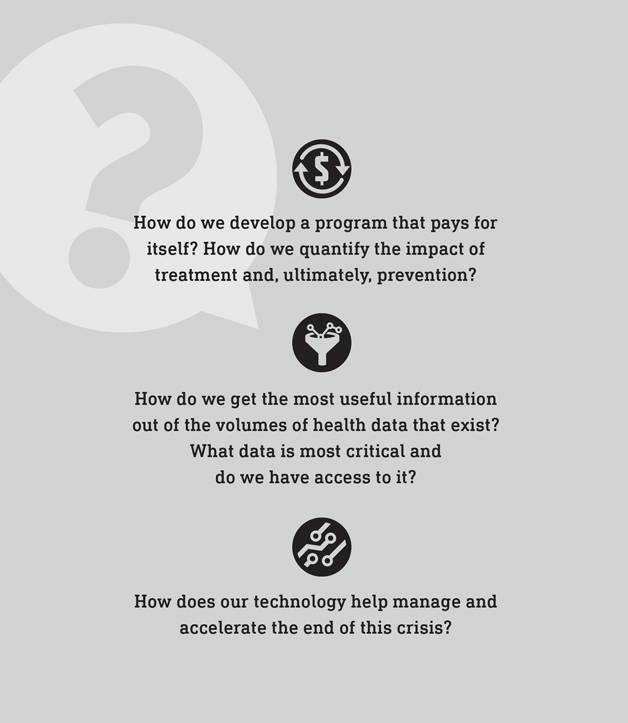The Opioid Crisis Response: Drawing from the Past to Predict the Future
With the opioid crisis coming to the fore of national conversation in 2017, many of our clients are now looking to understand what may come in 2018 and 2019 in terms of funding and programs to combat the disease.
Firms that traditionally serve the Federal Government stand ready and waiting to assist with the implementation of programs aimed at solving the problem. In the paper, we examine useful lessons-learned from past crises and indicators of possible priorities in a future federal opioid crisis response.
Currently, 91 Americans die every single day from opioid overdose. The opioid epidemic is a crisis of unprecedented scale and scope, affecting those from every income level and every region of the country, and there are few solutions in place to reverse this worrying trend.
While President Trump officially declared the opioid epidemic a “public health emergency” in October, no new funding for the fight followed. In fact, critical scientific agencies like the National Institutes of Health (NIH) face intensifying budget battles as the crisis worsens. The FY18 President’s Budget reduces the NIH’s funding from $32 Billion to $26 Billion, a move that could hurt the already small scientific efforts to combat opioid misuse and addiction.
In this climate of uncertainty, Avascent’s clients have been asking, “How can we help? What skills and capabilities from the government technology sector might be applied in this fight?”
Firms that traditionally serve the Federal Government stand ready and waiting to assist with the implementation of programs aimed at solving the problem. So, what might industry’s role be in the opioid crisis response, and what should government contractors expect in the next 18-24 months?
In analyzing how the federal government reacted to past public health crises, two key parallels to the current opioid crisis emerge:
- For significant federal funding to become available for a response to a public health crisis, government officials and the public must shift their thinking from a morality judgement to a disease mindset. As long as the afflicted are considered “at fault” in their behavior, government funding is hard to come by.
- When corporate interests tied to the substance at the heart of the crisis are anxious to settle, state and local legal pressure can lead to critical public health funding. The case of the tobacco industry offers one such example that offers some political and legal precedent with its $206 billion settlement in 1998.
In the sections that follow, there are useful lessons-learned from past crises and indicators of possible priorities in a future federal opioid crisis response.
Understanding Historic Catalysts for Funding
The HIV/AIDS epidemic of the 1980s and 90s is often invoked as a point of comparison to today’s opioid crisis. The two crises are similar in the scale of their devastation – 64,000 died of overdoses in 2016, exceeding the toll exacted by AIDS at the epidemic’s peak in 1995.
But by the time AIDS had hit its peak death toll, the federal government was already spending $3.5B in discretionary funds – $5.6B in today’s money – fighting the disease, and over a third of those discretionary funds were dedicated to research. Discretionary funds allocated to the opioid epidemic are less than $1B today.
One of the watershed moments that led to higher federal funding for a public health response to the AIDS crisis was the passage of the Ryan White CARE Act in 1990. Ryan White – an Indiana teenager – contracted AIDS through a tainted hemophilia treatment. Before Ryan White, AIDS was a disease stigmatized as an illness impacting the gay community, and those outside the community mostly chose to ignore the crisis.
The opioid epidemic parallels AIDS in this way, too – addiction, while recognized as a disease, is still looked upon by many as a moral failing. Despite being declared a public health emergency, this modern epidemic has not yet had its Ryan White moment, and without one, major programs and funding may be hard to come by.
Led by Mississippi’s then-attorney general, over 40 states took the four largest US tobacco companies to court. Their case was settled in 1998, and the manufacturers agreed to pay more than $200B over the first 25 years of the agreement.
But federal appropriations are not the only way to pay for a public health response. Lawsuits – as demonstrated by those levied against the tobacco industry in the late 1990s – can also be a key source of funds.
Led by Mississippi’s then-attorney general, over 40 states took the four largest US tobacco companies to court. Their case was settled in 1998, and the manufacturers agreed to pay more than $200B over the first 25 years of the agreement.
Those funds not only compensate states for some of the medical costs of caring for persons with smoking-related illnesses, but also pay for anti-smoking advocacy campaigns.
State attorney generals – again led by Mississippi – have begun suing prescription drug makers for their role in causing the opioid epidemic. So far, over 100 state, city, and county lawsuits have been filed – and that number continues to grow. Oxycontin maker Purdue is reportedly exploring the possibility of early settlement options; with the tobacco lawsuits as precedent, however, plaintiffs are unlikely to back down.
While the legal process is likely to be long, this could be a trigger at the end of the 18-24 month period that enables sustained public health campaign funding.
Predicting a Possible Federal Opioid Crisis Response Plan
While federal funding has been slow to ramp up in the opioid crisis response, there are a number of areas to which funds are either currently or expected to be allocated. These areas received funding at different stages of maturity during past crises and could have a material impact on managing the epidemic:
Offerings enabling public health officials to unilaterally tap into data resources and improve understanding of risk factors, prescribing habits, and triangulating geographic data are all potential ways that data collection and analytics can support government response efforts.
- Research and Development (R&D): Historically, this has been one of the best-funded areas in past responses. In the case of HIV/AIDS, approximately 39% of funding between 1995 and 2004 was dedicated to R&D. The main federal customer for opioid-related R&D is likely to be the NIH, which is currently funding grants spanning overdose prevention and reversal methods, treatment of opioid-use disorders, and novel treatments for chronic pain. While some of these approaches – like formulating stronger opioid antagonists – require mature capabilities now, others, like precision medicine or gene therapies, can be positioned for.[divider_padding]
- Monitoring & Analysis: Many states are actively exploring harnessing data to support targeted response efforts. State Prescription Drug Monitoring Programs (PDMPs), which can enable public health officials to track prescribing data in real-time, are the cornerstones of these efforts. While federal funding has historically been limited, recent bipartisan support of leveraging PDMPs and other technology platforms may drive future funding targeted at connecting federal and state systems. Offerings enabling public health officials to unilaterally tap into data resources and improve understanding of risk factors, prescribing habits, and triangulating geographic data are all potential ways that data collection and analytics can support government response efforts.[divider_padding]
- Public Health Campaigns: Currently, opioid abuse education and outreach programs are mostly carried out at the state and community level, often as part of school curriculums or athletic programs. The FDA is also targeting providers with education and awareness messages to cut down on opioid prescriptions. A sustained campaign may be difficult until the current crisis reaches its watershed moment. However, a long-term national campaign, similar to other substance-based outreach efforts like the CDC’s anti-smoking campaign, may develop in the future – especially if the lawsuits against opioid manufacturers are settled. Companies with health education and marketing expertise are sure to be well positioned for future opportunities.
Opioid Crisis Response Questions & Considerations for Industry
Health and technology firms will need to be ready to quickly apply solutions to the problem at hand once funding is allocated. Whether firms hire specially trained clinical staff, create new analytics capabilities, or develop qualifications in public health campaigns, allocating investments and positioning ahead of demand will be critical to enabling government in its fight against the opioid epidemic.
Industry is also in a unique position to ensure the response is effective, affordable and sustainable by drawing upon their experience in other relevant areas supporting federal customers. Accordingly, companies should consider the following questions to guide investment decisions in support of efforts to combat the opioid epidemic:

Avascent can help firms at any stage of development inventory their capabilities and determine the highest return-on-investment areas to ensure an opioid crisis response is ready when called on to help end America’s opioid crisis. We welcome your questions and discussion about how your firm might be positioned to help in the response.





